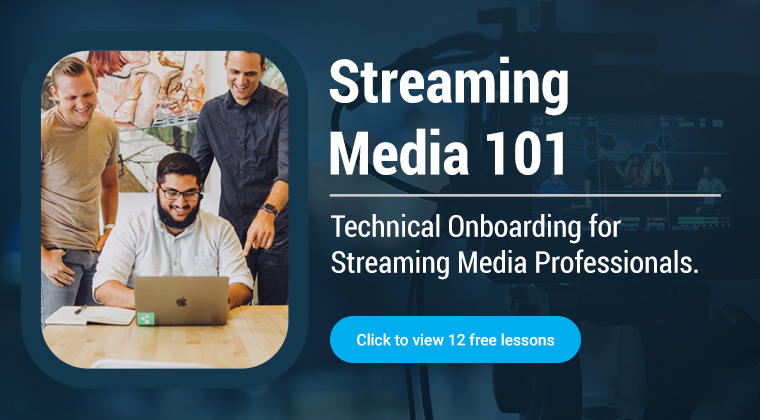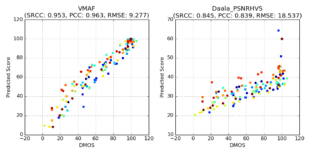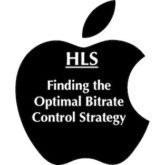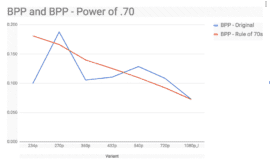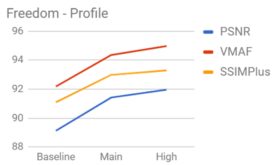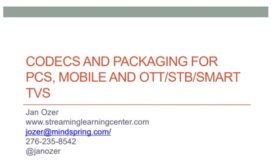On September 12, the Healthcare Information Committee of SW Virginia held a Healthcare Information Forum. In our tiny region of Virginia, all insurers had pulled out of the ACA, and there were many, many concerned and upset people in attendance (Anthem has since returned to the ACA market). One particularly informative speaker was Dr. Christina Dalton, shown above, who is …
Read More »Finding the Just Noticeable Difference with Netflix VMAF
VMAF stands for Video Multimethod Assessment Fusion, but all you really need to know is that it’s the video quality metric co-invented by Netflix to replace the Peak Signal to Noise Ratio (PSNR) that used to fuel the company’s per-title encoding function. In the image above, which is courtesy of Netflix, you see how VMAF scores on the left more closely match …
Read More »Lineup Set for Per-Title Encoding Webinar
Just a quick note about the Per-Title Encoding Webinar that I’m producing next Tuesday, August 29th, at 2:00 PM EST. In the webinar, after introducing the concept of per-title encoding, and discussing Netflix’s and YouTube’s technologies, I will compare three per-title approaches: – Capella Systems’ Source Adaptive Bitrate ladder, as implemented in their Cambria FTC encoder, which you can read …
Read More »RealNetworks Launches New Video Codec
RealNetworks is one of the most storied names in video streaming-if you’re on the wrong side of 40. If you’re younger, than odds are you never heard of the company. On Wednesday, August 16, RealNetworks announced an agreement to deploy Advanced RealMedia HD (RMHD) Technology in China. What do we know about the codec? Here’s a blurb from the product …
Read More »Apple’s Bitrate Control Strategy: Do as I Do, Not as I Say
Apple’s HLS Authoring Specifications for Apple Devices approves up to 200% constrained VBR but Apple’s actual encodes are more like 110-120% constrained. What Apple Says As you probably know, Apple recently made sweeping changes to their HLS recommendations, including changing from 110% constrained VBR for VOD in TN2224, to 200% constrained VBR in the HLS Authoring Specifications for Apple Devices …
Read More »Showing Three Options for HEVC in HLS in Webinar Today
I’m starting to get excited about the free Defining Your Encoding Ladder webinar today at 2:00 PM EST. In addition to a focus on reducing encoding and distribution costs (cut layers, cut ladders, cut bandwidth), I’ll be exploring three options for including HEVC in HLS presentations, and will be showing preliminary encoding ladders from MainConcept (hybrid HEVC/H.264), Bitmovin (HEVC only), …
Read More »Five Checks for your Encoding Ladder
Your encoding ladder controls the visual quality of all video that you deliver, but there are few absolutes. Ask five experts to design the optimal encoding ladder, and you’d get five different answers. That said, there are some tools and concepts you can use to identify where you may need to tweak our ladder, all providing a different lens to …
Read More »How PSNR Compares to VMAF and SSIMplus
As quality metrics go, PSNR is considered a blunt tool obsoleted by higher end metrics like Netflix’s VMAF or SSIMwave’s SSIMplus. That said, it’s accessible and understood, and has been used for years. Of course, none of that matters if it delivers misleading results. So that’s what I decided to test in a round of two tests. This is the first, …
Read More »Download Handout for Encoding 2017: Codecs & Packaging for PCs, Mobile & OTT/STB/Smart TVs
Download handouts from this session below. Here’s the description. As video resolutions increase and target playback platforms multiply, video producers must leave their H.264/HLS/HDS comfort zone and expand into HEVC, VP9, and MPEG-DASH. This workshop is divided into multiple segments by target platform to teach you the applicable standards and best strategies for delivering live and VOD adaptive video to …
Read More »Ozer Announces Rebuild Your Encoding Ladder Webinar Series
In case you haven’t noticed, I’ve updated the Streaming Learning Center design to enable an improved learning experience. As part of this redesign, I’ll be holding more educational webinars. The first is a six-part webinar series entitled Rebuild Your Encoding Ladder. If you haven’t looked at your encoding ladder in awhile, you’ll find this course particularly useful as Apple has completely changed …
Read More » Streaming Learning Center Where Streaming Professionals Learn to Excel
Streaming Learning Center Where Streaming Professionals Learn to Excel

